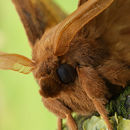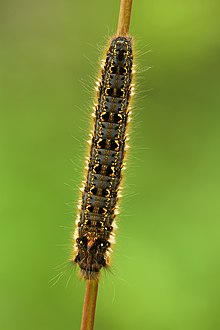en
names in breadcrumbs


Euthrix potatoria, the drinker, is an orange-brown moth of the family Lasiocampidae.[1]
The species' common and scientific names derive from the larva's supposed drinking of drops of dew.[2]
The scientific name Euthryx potatoria was given to this moth by Carl Linnaeus in 1758. In choosing the name potatoria ‘drinker-like’, he was inspired by the Dutch entomologist Johannes Goedaert, who had called the animal dronckaerdt ‘drunkard’ “because it is very much inclined to drinking”.[3] This remark refers to the moth’s habit of repeatedly plunging its head into the water.[4] The English name drinker (moth) also refers to Goedaert’s analogy.
Subspecies include:[1]
This species can be found in Europe.[5] The species is fairly common in the southern half of Britain. In Scotland, it is common in the west but not in the east of the country.[1] It is most frequently found in marshy places, fens and riversides but may also be seen in drier, grassy terrain.[6][7]
In a recent survey to determine the status of all macro moths in Britain this species was classified as common.
The imago has a wingspan of 45–65 mm. The yellowish females are slightly larger than the orange-brown male but both sexes usually show the two distinctive white spots on the forewing.[7] Females have slightly serrated antennae, while male have deeply combed antennae.[8]
The fully grown larva is about 6 cm long, hairy, striped and spotted, with distinctive tufts fore and aft. Larvae hibernate while young and resume feeding in the spring, pupating in a cocoon during the summer.[6]
This nocturnal moth flies from June to August depending on the location. Males especially are attracted to light.[6][7] The females lay their eggs in small clusters, mainly on the stem of grasses or reeds.[8] The larvae feed on various grasses and reeds (Alopecurus, Deschampsia, Dactylis, Elytrigia, Carex, Luzula and other Gramineae).[9]
 Caterpillar
Caterpillar Euthrix potatoria, the drinker, is an orange-brown moth of the family Lasiocampidae.
The species' common and scientific names derive from the larva's supposed drinking of drops of dew.